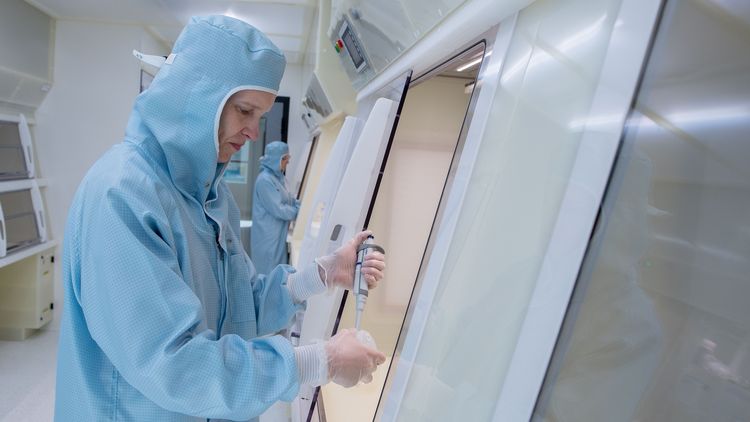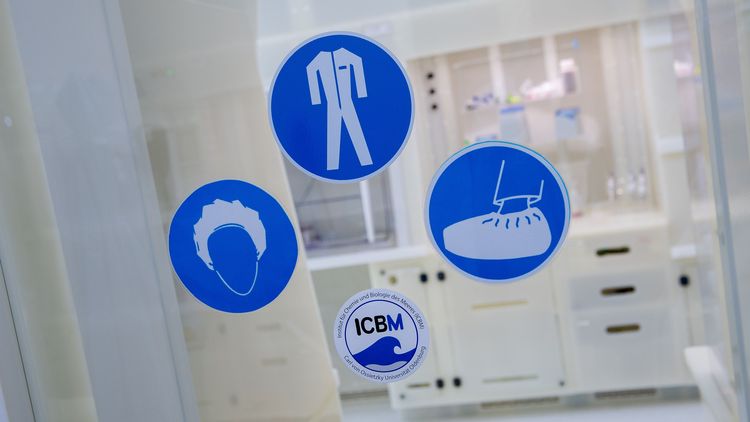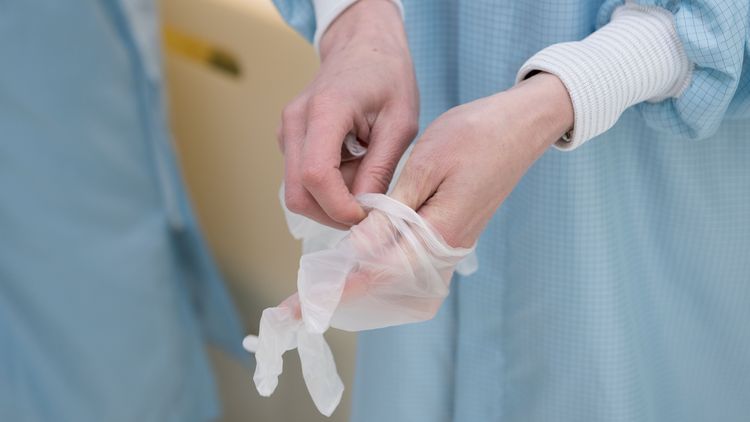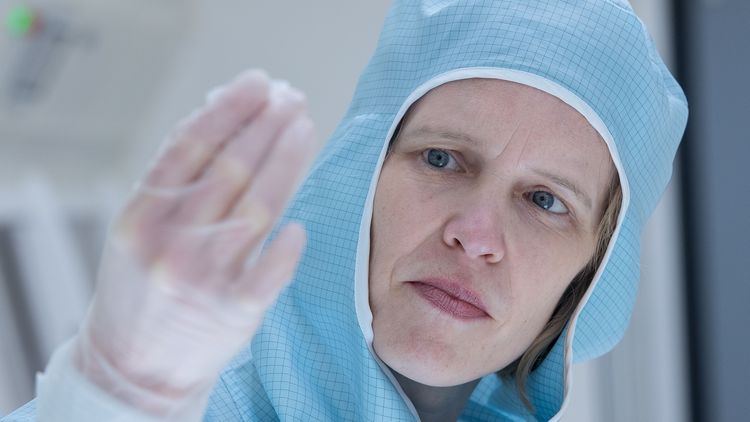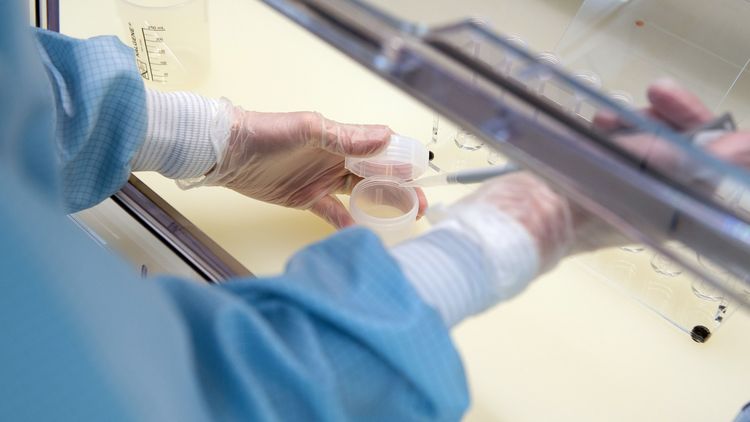Tiny amounts of various metals are dissolved in the waters of the world’s oceans. Oldenburg geochemist Katharina Pahnke-May is studying the precise distribution of a group of these substances which can serve as markers for ocean currents – and reveal a lot about their origins.
Seawater is often talked about as a source of raw materials: all together the world’s oceans contain an estimated 20 million tonnes of gold. This gold is worth around ten times the global gross domestic product. The precious metal cannot be extracted for economic purposes, however, as each litre of seawater contains only homeopathic amounts, somewhere in the range of a few billionths of a gram per litre. “To give an idea of how tiny these concentrations are, I like to use Olympic swimming pools for comparison,” says Dr. Katherina Pahnke-May. The geochemist explains that a pool that is 50 metres long, 25 metres wide and 2 metres deep holds 2,500 cubic metres of water. If you were to dissolve a drop of cough syrup with a volume of 0.05 millimetres into twenty times the amount of water in that pool, you would end up with a ratio of one to one billion – a 1 followed by twelve zeros. “That’s the order of magnitude we’re dealing with,” says Pahnke-May.
Pahnke-May’s area of expertise is marine isotope geochemistry. The researcher and her colleagues from the Max Planck research group of the same name at the University of Oldenburg are studying concentrations of trace metals in different marine regions and measuring the ratios of their isotopes –variants of these elements with different atomic masses. Gold is not among the substances that the group is tracking, but many other metals are distributed in the oceans in similarly tiny concentrations. Neodymium, for instance, an element from the rare earth family, as well as lead, strontium, iron and silicon. These substances are dissolved in seawater or contained in tiny particles of dust that are blown by the wind or washed down rivers from the continents into the sea.
Pahnke-May and her colleagues can infer astonishing stories from the seemingly trivial variations in the composition of these seawater substances. On the basis of these trace elements they can, for example, determine the extent to which the different water masses in the oceans mix with each other, the effect of continental influences on the chemical composition of seawater, or where the nutrients come from that cause algae to bloom in the middle of the Pacific. These extremely fine admixtures can even reveal the paths an ocean current has taken in the past – information that plays an important role in climate studies.
As Pahnke-May points out, marine isotope geochemistry is still a relatively young field. But thanks to improved measuring techniques it is attracting more and more attention. “It is becoming increasingly clear how useful trace elements are for gaining a better understanding of the geochemistry of the sea,” she says. For their studies she and her team primarily use substances that are not integrated into biological cycles, because with these substances the isotope ratios change only when different water masses mix with each other. They act as a “fingerprint” of an ocean current, so to speak.
Dust-free work in the cleanroom laboratory
Pahnke-May and her team have to go to extraordinary lengths to coax secrets from the oceans. Even more complicated than extracting the minute quantities of trace elements from seawater is the process of measuring their isotope ratios. “For neodymium isotope measurements, we need up to 20 litres of water for a single measurement,” she explains. Another problem is that the samples can be contaminated by rust from ships or dust particles in the air. To prevent this from happening, the Oldenburg geochemists use special equipment for sample taking – for example large Teflon-coated water bottles that have no metal springs in their closing mechanism and are attached to a plastic-coated steel cable.
The researchers also work with extreme care when preparing the samples. Since 2015 they have the use of a metal-free ultra-clean laboratory where there are no unprotected metal surfaces that can release rust particles and the air is practically dust-free. A sophisticated air conditioning system sucks up every single particle that strays into any of the work stations protected by special Plexiglas panes.
It was in 2006, during her time as a postdoctoral researcher at Columbia University in New York, that Pahnke-May started to take an interest in trace metals. After completing her geology degree in Kiel, Germany, and her PhD at Cardiff University in Wales she transferred to the US, working first at the Massachusetts Institute of Technology in Cambridge and then at the renowned Lamont Doherty Earth Observatory, which belongs to Columbia University. At the time, a new research programme was being launched to chart the concentrations of various trace substances in the oceans. Under the name of “Geotraces”, this international project began its first research trips in 2009, with the aim of measuring the distribution of micronutrients such as iron and other trace elements in the ocean. The element neodymium and its isotopes are also on the list as markers for ocean currents. The modern distribution of this substance forms the basis for drawing conclusions about the past. Pahnke-May, who up to that point had focused on paleooceanographic topics, coordinated the preliminary work for the neodymium measurements. “My main area of interest is still trace metals and their isotopes in the sea because so much research remains to be done in this field and we can address so many interesting questions using these markers,” she explains.
The researcher spent a total of eleven years abroad. “Oldenburg is so attractive that in 2011 I was quite happy to return to northern Germany from the tropical paradise of Hawaii,” she says with a chuckle. She then took charge of the newly established Max Planck Research Group Marine Isotope Geochemistry, which is part of the Max Planck Institute for Marine Microbiology in Bremen and Oldenburg’s Institute for Chemistry and Biology of the Marine Environment (ICBM).
Since then she and her team of nine researchers have had considerable success. Pahnke-May and her colleague Dr. Henning Fröllje discovered that the islands of Hawaii are an important source of trace substances in the Central Pacific – and that dust from the Asian continent is less important than previously thought. Other volcanic islands also leave what could be described as a trail of dirt in the Pacific, as a study by Melanie Behrens, a member of Pahnke-May’s group, shows. Behrens, now a post-doctoral researcher, discovered that the island of New Guinea apparently leaves its own chemical imprint on the currents in the tropical Pacific.
The current measurements also serve as a basis for tracking future changes, for instance the impact of climate change on the Arctic. Three researchers from Pahnke-May’s group are currently analysing water samples from the central Arctic Ocean for traces of neodymium, other rare earth elements and silicon. They want to determine where and how exactly these elements are entering the Arctic region and what factors influence their geochemical cycles. In the future, scientists will be able to use this information to determine the impact of the melting of marine ice and permafrost areas on the input of substances. Other projects focus on the pathways of trace elements into the sea. Here, for example, the Oldenburg scientists analyse water samples taken from the River Weser estuary or ground water that flows below sea level into the North Sea, as on Spiekeroog Island.
Prehistoric evidence on the seafloor
Through comparisons with present-day conditions, scientists can also determine whether particular ocean currents took a different route in the past. This look back at prehistoric times requires detective work that is almost more complicated than the analysis of the present. The members of Pahnke-May’s research team have to track down pieces of evidence in drill cores taken from the seafloor. For example, the sediment contains the shells of single-cell organisms covered by an iron-manganese coating, or the tiny teeth of fossilised fish. These remnants that have formed in the ocean contain the isotope ratio of seawater from the time of their formation.
On the basis of fish teeth found in the South Pacific, Pahnke-May’s team and several of their colleagues were able to prove that during the last ice age, the stratification of the Southern Ocean was considerably more pronounced than it is today. This discovery, which was published in the renowned journal Science in February 2018, is a key piece of the puzzle posed by the mysterious rise in temperatures towards the end of the last ice age. The researchers concluded from their measurements that during the last ice age the deep ocean was able to store large amounts of CO2 . The scientists’ measurements show that as temperatures began to rise, water masses increasingly mixed with each other, releasing the greenhouse gases stored in the deep Southern Ocean into the atmosphere and increasing the rise in temperatures.
The Oldenburg geochemists are doing important pioneering work: piece by piece they are filling in the picture of how trace metals are distributed in the oceans, determining their geochemical cycling in the ocean and where they come from. Katharina Pahnke-May will spend several more years working on this fundamental task. One thing she knows for sure: “If we close the critical gaps in knowledge, we will have a better understanding of how the oceans have changed in the past and be better equipped to predict the future.”

